Enhance the Growth and Quality of your Crops, Improve Soil Health, Use Garden Space Efficiently and Keep Pests at Bay
Easy to grow, Basil is an excellent addition to the herb garden and a valuable addition to the vegetable garden. Its sweet aroma and strong flavor make it popular in various cuisines. Sweet Basil is the quintessential Italian culinary herb, most famous for its use in pesto. Basil leaves are also used fresh or dried to flavor meats, fish, salads, and sauces.
Use Basil as a companion plant in your garden to help attract beneficial insects for your other crops or enhance their flavor.
Companion planting is an organic method of preventing or protecting plants from pests and diseases, attracting the right types of insects for pollination, enhancing nutrient uptake, and increasing crop production simply by growing specific plants near each other. In essence, companion planting helps bring a balanced ecosystem to your landscape, allowing nature to do its job.
1. Organic Pest control
Some plants can emit scents that either repel insects, attract them, or confuse insects or disease organisms in search of their favorite host plants. They make insects less likely to land on your garden vegetables.
2. Attracts beneficial insects
Some plants help attract beneficial insects, such as ladybugs, bees, and butterflies, that pollinate and help control harmful bugs. Beneficial insects feed on common garden pests, like aphids and caterpillars.
3. Provides necessary shade
Tall sun-loving plants offer shade to smaller shade-loving plants. This results in better products and can also potentially provide pest control. A good example is The Three Sisters Garden. Practiced by Native Americans thousands of years ago, this garden includes corn, beans, and squash. The tall corn provides shade for the lower squash but also stops the squash vine borer beetle.
4. Shelters plants
Some plants can provide windbreaks and prevent soil erosion. Strong winds can damage gardens by removing mulch, topsoil, and eroding beds and hillsides. Rain can also cause severe damage by beating down young seedlings. By carefully selecting the right ground cover, you can help prevent soil erosion.
5. Provides natural supports
Some companion plants can physically support each other, reducing the need for staking. The example of planting corn, beans, and squash together applies here again. Corn provides tall stalks for the beans to climb so that they are not out-competed by sprawling squash vines.
6. Saves space
Interplanting different crops greatly maximizes space and improves productivity in small gardens.
7. Enhances flavors
Some plants can subtly enhance the flavor of other plants. Most herbs have been found to enhance the flavor of fruits and vegetables grown nearby, and Basil grown beside tomatoes is an excellent example. Similarly, chamomile has an aromatic scent that is believed to improve the growth and flavor of cabbages, cucumbers, and onions when grown beside them.
8. Better soil quality and fertility
Some crops help fix nitrogen from the atmosphere and reduce fertilizer needs. Similarly, planting plants with different root structures together can aerate the soil and allow plants to pull nutrients from different parts of the soil.
Not only can companion planting helps your plants to grow better, but it also makes the vegetable garden more attractive thanks to the addition of colorful flowers that help or hinder nearby vegetables. Companion planting combines beauty and purpose to create an enjoyable, healthy environment.
 |
Asparagus Basil grows well paired with asparagus. Basil and asparagus attract beneficial insects (e.g., ladybugs), which helps control the presence of aphids and other pests in the garden. Basil repels flies and mosquitoes, reducing the need for chemical pesticides. Basil repels the asparagus beetle, which feeds on the tender tips of new asparagus shoots. In turn, asparagus shelters basil from strong winds. |
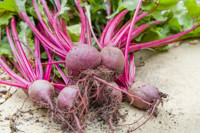 |
Beets The leafy green tops of beets benefit from the pest-repelling aromas of nearby basil plants. Basil is a companion that can improve the growth and flavor of your beets. |
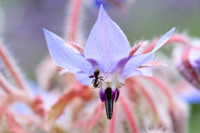 |
Borage Borage is a good companion plant for Basil because it attracts pollinators, such as bees and other beneficial insects, to the garden. Borage may also draw out essential minerals from the soil that may be utilized by your Basil to enhance its development and vigor. Borage helps your Basil grow and taste better. |
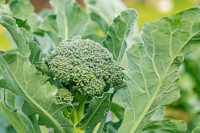 |
Broccoli Basil attracts beneficial insects to your broccoli plant but also prevents aphids from attacking your broccoli. Basil also keeps white flies, hornworms, and beetles away from other plants. |
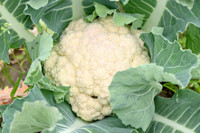 |
Cauliflower Basil attracts beneficial insects to your cauliflower plant but also prevents aphids from attacking your cauliflower. Basil also keeps white flies, hornworms, and beetles away from other plants. |
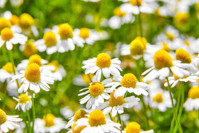 |
Chamomile Chamomile makes a good companion to Basil in the herb garden because its presence increases the amount of essential oil that Basil produces. This enhances the flavor of your Basil in culinary preparations and increases its skills as a pest-repellent in the garden. |
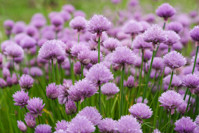 |
Chives
Chives enhance the flavor of your Basil. |
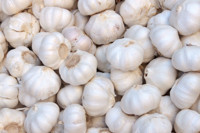 |
Garlic Both basil and garlic aid in the prevention of spider mites, aphids, and whiteflies, resulting in a healthier garden patch and better harvests. Basil and garlic are said to enhance one another’s flavors when grown together. Garlic can also keep away squirrels and rabbits. |
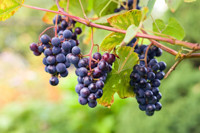 |
Grapes Basil can repel bad insects away from your grapes. |
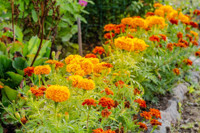 |
Marigolds Basil and marigolds make great companion plants because they benefit from each other’s qualities. Basil and marigolds naturally repel pests. When planted in tandem, they emit a strong smell that deters garden pests such as aphids, beetles, and nematodes. Pairing basil with marigolds can also prevent slugs and snails from harming your Basil. |
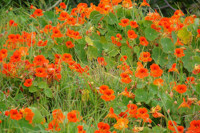 |
Nasturtium Nasturtium is a good companion plant for Basil because it acts as a trap crop. Nasturtium traps pests such as aphids away from your Basil. In addition, Nasturtiums add cheerful color to the garden, and their flowers are edible. |
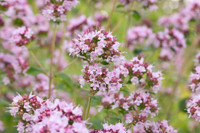 |
Oregano Oregano enhances the flavor of your Basil. Oregano helps increase essential oil content in neighboring plants and makes Basil more potent as a pest repellent. When oregano is in bloom, it might draw beneficial insects. |
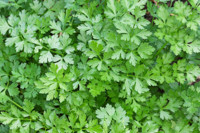 |
Parsley Basil and parsley are great companion plants. They share similar growing requirements. Both need full sun, well-draining soil, and consistent moisture. Basil and parsley are more effective when planted together as companions for other plants, like asparagus and brassicas. |
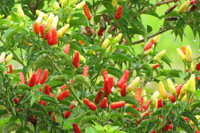 |
Peppers Basil grows well when paired with bell peppers and chili peppers. Basil improves the growth and flavor of peppers. Basil aids in deterring several common garden pests, such as aphids, spider mites, thrips, mosquitoes, and flies that are often attracted to peppers. |
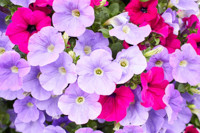 |
Petunias Petunias are a great companion plant for the herb garden. Petunias repel many annoying pests, including asparagus beetles, leafhoppers, aphids, and tomato worms. Petunias also offer cheerful colors to your herb or vegetable garden. |
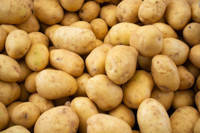 |
Potatoes Basil improves the flavor of peppers. Basil aids in deterring several common garden pests, such as aphids or potato beetles. Basil is thought to promote a stronger root system in potatoes. |
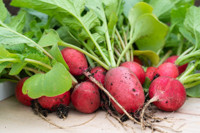 |
Radishes Radishes can be used as row markers – they mark out the row where your Basil has been sown. Radishes are a good companion plant for Basil because they benefit from the pest-repelling aromas of nearby basil plants. |
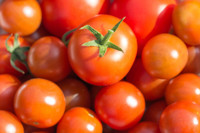 |
Tomatoes
Basil improves the growth and flavor of tomatoes. |
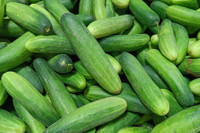 |
Cucumbers Aromatic herbs, like Basil, can affect the taste of your cucumber |
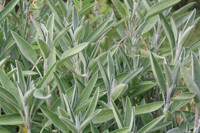 |
Sage Sage and other aromatic herbs can stunt the growth of your cucumbers. |
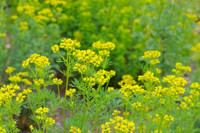 |
Rue Rue should also be kept away from Basil. Basil and rue dislike each other. Perhaps this is because Basil is sweet and rue is very bitter. |
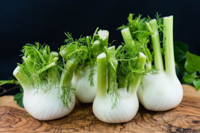 |
Fennel Fennel is one of the few plants that has mostly bad companions. Most plants dislike Fennel, and it should be planted well away from the vegetable garden. Fennel inhibits the growth of any nearby plant, including Basil. |
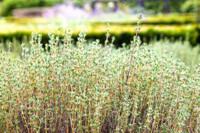 |
Thyme Although thyme is an aromatic herb like Basil, Thyme and Basil do not share the same growing requirements. Thyme prefers drier and sandier soils, while Basil prefers more moist soils. |
| Hardiness |
2 - 11 |
|---|---|
| Plant Type | Annuals, Herbs, Perennials |
| Genus | Ocimum |
| Exposure | Full Sun |
| Season of Interest |
Spring (Late) Summer (Early, Mid, Late) Fall |
| Maintenance | Low |
| Water Needs | Average |
| Soil Type | Loam, Sand |
| Soil pH | Acid, Alkaline, Neutral |
| Soil Drainage | Well-Drained |
| Characteristics | Fragrant |
| Tolerance | Deer, Rabbit |
| Attracts | Butterflies |
| Landscaping Ideas | Beds And Borders, Patio And Containers |
| Garden Styles | City and Courtyard, Informal and Cottage, Mediterranean Garden |
123rf
| Hardiness |
2 - 11 |
|---|---|
| Plant Type | Annuals, Herbs, Perennials |
| Genus | Ocimum |
| Exposure | Full Sun |
| Season of Interest |
Spring (Late) Summer (Early, Mid, Late) Fall |
| Maintenance | Low |
| Water Needs | Average |
| Soil Type | Loam, Sand |
| Soil pH | Acid, Alkaline, Neutral |
| Soil Drainage | Well-Drained |
| Characteristics | Fragrant |
| Tolerance | Deer, Rabbit |
| Attracts | Butterflies |
| Landscaping Ideas | Beds And Borders, Patio And Containers |
| Garden Styles | City and Courtyard, Informal and Cottage, Mediterranean Garden |
Create a membership account to save your garden designs and to view them on any device.
Becoming a contributing member of Gardenia is easy and can be done in just a few minutes. If you provide us with your name, email address and the payment of a modest $25 annual membership fee, you will become a full member, enabling you to design and save up to 25 of your garden design ideas.
Join now and start creating your dream garden!
Create a membership account to save your garden designs and to view them on any device.
Becoming a contributing member of Gardenia is easy and can be done in just a few minutes. If you provide us with your name, email address and the payment of a modest $25 annual membership fee, you will become a full member, enabling you to design and save up to 25 of your garden design ideas.
Join now and start creating your dream garden!